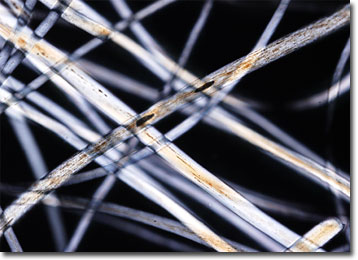Polarized Light Microscopy Digital Image Gallery
Cashmere
Though the term cashmere is sometimes applied to wools that feel very soft to the touch, it only correctly refers to the downy hairs of the Kashmir goat. This silky material, which comprises the animalís undercoat, is notoriously warm, soft, and fine when woven into sweaters and other apparel items.

Cashmere originally came to be known to the larger world through the beautiful handmade shawls produced in Kashmir, India beginning in the fifteenth century. The fiber utilized to create the shawls was originally known as pashm. However, as the garments became popular in Europe in the early 1800s, the goat hair began to be referred to as Kashmir in reference to its origin, which eventually evolved into the modern spelling of the word. In the Industrial Age, several countries began producing shawls in the likeness of those found in Kashmir, but through mechanical means, making them much cheaper to produce. In the face of heavy competition, the industry in India suffered severely.
The process of obtaining fine cashmere is difficult and time consuming. First, the material is typically combed out or pulled by hand from live goats, though in some areas it is sheared or obtained from butchered animals. The fiber must then undergo a thorough cleaning process to ensure that it does not contain any grease or debris. Perhaps the most important process that must be carried out, however, is the separation of the fine hairs from the coarse. Indeed, many producers of cashmere will not reveal how they actually complete this step, keeping it as a closely guarded secret because the ratio of fine hairs to coarse is what primarily determines the materialís grade and commercial value.
